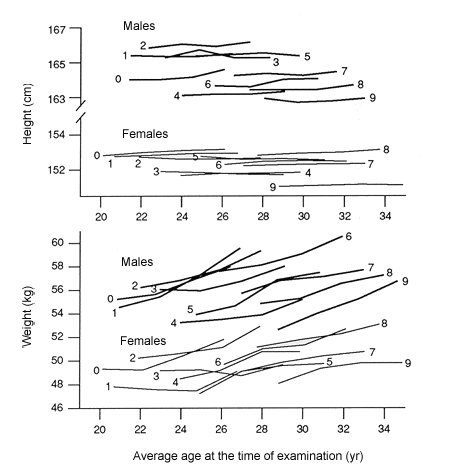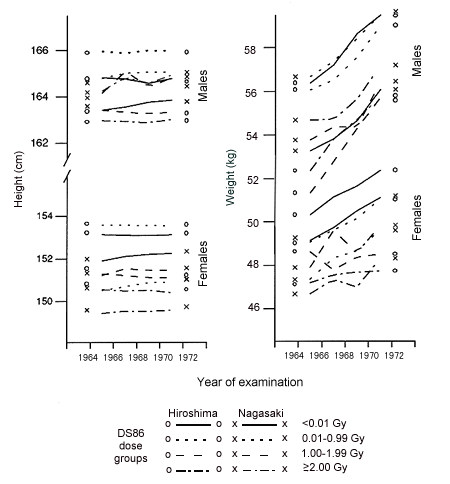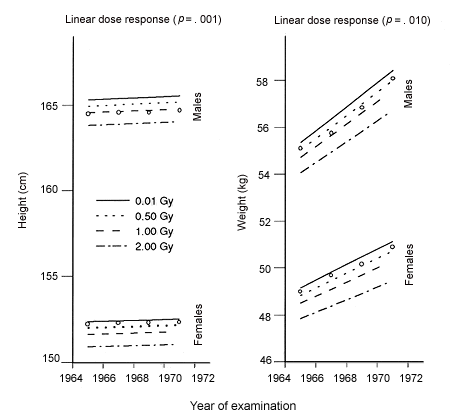Growth and Development of Atomic-bomb Survivors Exposed during Childhood
Results of the author’s analysis suggest an association between radiation exposure at ages under 10 years and subsequent altered patterns of growth.
by Masanori Otake, Department of Statistics, RERF
This article was originally published in RERF Update 5(3):3,4,10, 1993.
In 1958, clinical examinations of about 20,000 atomic-bomb (A-bomb) survivors began as part of the Atomic Bomb Casualty Commission’s Adult Health Study (AHS). Still continuing today, the AHS examinations have biennially collected many physiological and biochemical measurements, including body size. A recent analysis of repeated measurements of stature recorded at various times among the prenatally exposed A-bomb survivors (M Otake et al, Radiat Res 134:94-101, 1993) has revealed a significant growth retardation associated with radiation exposure among survivors exposed during the first and second trimesters of pregnancy.
In this study, we evaluated growth retardation in persons exposed when less than 10 years old. The analysis was based on repeated measurements of height and weight made during the fourth through seventh examination cycles (1964-1972). The observed mean heights and weights for ages 0-9 years at the time of the bombings (ATB) showed a definite trend when subjects for both cities were combined after categorization by sex and average age at the time of examination (ATE) (Figure 1). The observed mean values for height and weight, plotted in Figure 2 by city, sex, Dosimetry System 1986 (DS86) dose group, and examination-cycle year, differed slightly between Hiroshima and Nagasaki according to DS86 dose group. The mean heights by sex and average age ATE appeared to have remained unchanged for the 1964-1972 period, and mean weights by sex and average age ATE increased with average age ATB.

Figure 1. Mean value of height and weight by sex, age at examination, and age at exposure for examination cycles 4-7.
Numbers located near the lines indicate the age (yr) of the subcohort at the time of the bombings.

Figure 2. Observed mean values of height and weight of persons 0-9 years old at the time of the bombings. DS86 = Dosimetry System 1986.
Using statistical methodology known as growth-curve analysis, the relationships between height, weight, and age ATE were modeled. Since by 1964, most of the subjects had reached the adult stage of growth and development (ie, they were over 18 years old), growth could be analyzed without the complexities that arise in attempts to model the adolescent growth spurt, which differs greatly between men and women. We found that altered patterns of secondary growth seemed to depend upon exposure before the age of 3 years. When the subjects were categorized by examination cycle, correlation between height and weight was significant–ranging from 0.41 to 0.46. A multivariate approach using as covariates city, sex, DS86 dose group, and age ATB was considered more suitable than application of a cross-sectional technique by examination cycle.
A highly significant growth retardation associated with radiation exposure was observed when subjects were analyzed according to DS86 group and the analysis was restricted to the 567 individuals for whom at least four repeated measurements of height and weight had been recorded. The restriction to only those individuals with a complete set of height and weight measurements was made because our growth-curve model is not yet applicable to a series of multivariate measurements from which values are missing. An additional analysis, carried out to examine the effect of extending the analysis to include the 254 individuals with measurements from only three examination cycles, yielded an identically significant growth retardation. For the 254 persons, missing measurements were estimated from simple linear-regression models for height and weight fit to the three available values for each person. Among the several comparisons made by city, sex, DS86 dose, and age ATB, the most significant difference was between males and females. These were a 12.5-cm difference in height and about a 7-kg difference in weight.
Values for Hiroshima and Nagasaki differed significantly. On average, persons in Hiroshima were roughly 2.1 cm taller and 2.1 kg heavier than those in Nagasaki. The radiation-related growth retardation due to A-bomb radiation exposure was significant. Survivors with doses in excess of 2 Gy were on average 1.5 cm shorter and 1.5 kg lighter than survivors with DS86 dose estimates less than 0.01 Gy, after adjustment for city, sex, and age-ATB effect (Figure 3).

Figure 3. Observed and expected values for height and weight of subjects who were 0-9 years old at the time of the bombings.
Observed total means of height and weight are plotted with circles.
Although there seems to be a clear relationship between A-bomb radiation exposure and altered patterns of growth and development, it is difficult to evaluate the possible contributing effects of other factors, such as nutritional deprivation and disruption of normal family life in the years immediately following World War II. Reporting in 1966 on the results of a mail survey about cardiovascular disease (ABCC Technical Report 19-66), H Kato et al noted there was little difference by occupation or educational level among the exposed groups; however, the nonexposed differed from the exposed. In regard to housing conditions, the area per person did not differ significantly with exposure status in either Hiroshima or Nagasaki. The subjects of this survey were limited to the exposed population.
Since stature is primarily a result of genetic influences, the size of the parents would have been a useful covariate in evaluating a subject’s expected adult height; however, parental height and weight were not available to us. In 1971, J Belsky et al noted that there was no significant height variation by dose for subjects aged 20-49 years ATB, an age range that includes the generation of the parents of the children who were 0-9 years old ATB (ABCC Technical Report 9-71).
Using the growth-curve model to examine the effects of socioeconomic factors, we evaluated as covariates occupation, education, household ownership, and eating habits (classified as Japanese, western, and Chinese cooking styles) that were available from the AHS epidemiological questionnaire for 1963-1968. When compared with multivariate repeated measurements of height and weight, no significant difference among such concomitant variables was observed, but growth retardation associated with radiation exposure was manifest. Based on the growth-curve model, nutrition and socioeconomic status appeared to have a greater influence on the background estimates of parameters than either dose or age ATB. We have, therefore, assumed that concomitant factors, such as nutrition and socioeconomic status, affected equally all individuals studied, regardless of radiation exposure. It also seems reasonable to assume that genetic factors (ie, parental characteristics) affected members of a randomly selected population equally.

